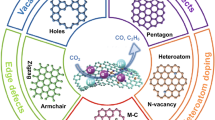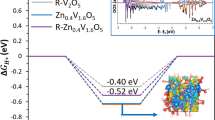Abstract
Palladium-containing ordered mesoporous carbons, such as CMK-1 and CMK-3 doped with nitrogen by pyrolysis of polyaniline and modified with an imidazolium ionic liquid ([BMIM][Br]) have been synthesized. The carriers and electrocatalysts have been studied by low-temperature nitrogen adsorption, thermogravimetric analysis, X-ray fluorescence analysis, and Raman spectroscopy. A significant decrease in the surface of CMK materials was shown upon doping with nitrogen and modifying with an ionic liquid. Moreover, the electrocatalytic activity in the oxygen reduction reaction from an alkaline electrolyte has been studied by the potentiometric method using a three-electrode cell with a rotating disk as working electrode. In addition, the diffusion currents, half-wave potentials, initial potentials, and the number of electrons participating in the reaction are calculated. The values of the electrochemical active surface of the synthesized catalysts were determined on the basis of cyclic voltammograms. Modification CMK-3_Pd with ionic liquid made it possible to increase the diffusion current, which was not observed upon doping with nitrogen. Catalysts CMK-3_Pd and CMK-3_Pd_IL showed high efficiency in the reaction under study. The number of electrons transferred during the electroreduction of oxygen on these catalysts is about 3.5; mass activity in the diffusion region at a potential of −0.8 V is about 0.7 A/mgPd; and it is almost two times higher than that of the commercial platinum Pt/C catalyst. In the kinetic region at a potential of −0.05 V, the specific activity of the platinum catalyst is significantly higher than that of CMK-3_Pd and CMK-3_Pd_IL. Mass activity in the kinetic region for CMK-3_Pd and CMK-3_Pd_IL is comparable to the activity of the Pt/C platinum catalyst. It was shown that the activity of materials based on CMK in the reaction of oxygen electroreduction from an alkaline electrolyte will depend not only on the size of the electrochemically active surface of the catalysts, but also on the textural characteristics of these materials.
Graphical abstract















Similar content being viewed by others
References
Daud WRW, Rosli RE, Majlan EH, Hamid SAA, Mohamed R, Husaini T (2017) PEM fuel cell system control: a review. Renew Energ 113:620–638
Wang Y, Diaz DFR, Chen KS, Wang Z, Adroher XC (2020) Materials, technological status, and fundamentals of PEM fuel cells–a review. Mater Today 32:178–203
Zeng WJ, Tong L, Liu J, Liang HW (2022) Annealing-temperature-dependent relation between alloying degree, particle size, and fuel cell performance of PtCo catalysts. J Electroanal Chem 922:116728
Jung WS, Kim T, Popov BN (2022) Development of highly active and stable catalyst supports and platinum-free catalysts for PEM fuel cell. J Electrochem Soc. https://doi.org/10.1149/1945-7111/ac7827
Chandran P, Ghosh A, Ramaprabhu S (2018) High-performance platinum-free oxygen reduction reaction and hydrogen oxidation reaction catalyst in polymer electrolyte membrane fuel cell. Sci Rep 8:3591. https://doi.org/10.1038/s41598-018-22001-9
Tarasevich MR, Davydova ES (2016) Nonplatinum cathodic catalysts for fuel cells with alkaline electrolyte. Russ J Electrochem 52:193–219
Wang W, Wang Z, Wang J, Zhong CJ, Liu CJ (2017) Highly active and stable Pt–Pd alloy catalysts synthesized by room- temperature electron reduction for oxygen reduction reaction. Adv sci 4:1600486
Maiyalagan T, Alaje TO, Scott K (2012) Highly stable Pt–Ru nanoparticles supported on three- dimensional cubic ordered mesoporous carbon (Pt–Ru/CMK-8) as promising electrocatalysts for methanol oxidation. J Phys Chem C 116:2630–2638
Ruiz-García C, Heras F, Calvo L, Alonso-Morales N, Rodríguez JJ, Gilarranz MA (2019) N- doped CMK-3 carbons supporting palladium nanoparticles as catalysts for hydrodechlorination. Ind Eng Chem Res 58:4355–4363
Tan X, Zhang J, Wu X, Wang Y, Li M, Shi Z (2018) Palladium nanoparticles loaded on nitrogen and boron dual-doped single-wall carbon nanohorns with high electrocatalytic activity in the oxygen reduction reaction. RSC Adv 8:33688–33694
Zhu H, Zhang S, Huang YX, Wu L, Sun S (2013) Monodisperse M x Fe3–x O4 (M= Fe, Cu Co, Mn) nanoparticles and their electrocatalysis for oxygen reduction reaction. Nano Lett 13:2947–2951
Guo C, Li Y, Li Z, Liu Y, Si Y, Luo Z (2020) Nanochannel-controlled synthesis of ultrahigh nitrogen-doping efficiency on mesoporous Fe/N/C catalysts for oxygen reduction reaction. Nanoscale Res Lett 15:1–14
Zaitseva YN, Novikova SA, Parfenov VA, Vyatkin AS, Ryzhkov II (2019) Synthesis and electrochemical properties of CMK-3 with particles of nickel, cobalt and copper. J Siberian Federal Univ Chem 12:395–404
Vij V, Sultan S, Harzandi AM, Meena A, Tiwari JN, Lee WG, Kim KS (2017) Nickel-based electrocatalysts for energy-related applications: oxygen reduction, oxygen evolution, and hydrogen evolution reactions. ACS Catal 7:7196–7225
Zhao Y, Chu Y, Ju X, Zhao J, Kong L, Zhang Y (2018) Carbon-supported copper-based nitrogen- containing supramolecule as an efficient oxygen reduction reaction catalyst in neutral medium. Catalysts 8:53
Patil RB, Mantri A, House SD, Yang JC, McKone JR (2019) Enhancing the performance of Ni-Mo alkaline hydrogen evolution electrocatalysts with carbon supports. ACS Appl Energ Mat 2:2524–2533
Laszczyńska A, Tylus W, Szczygieł I (2021) Electrocatalytic properties for the hydrogen evolution of the electrodeposited Ni–Mo/WC composites. Int J Hydrog Energ 46:22813–22831
Sun J, Li S, Zhang Q, Guan J (2020) Iron–cobalt–nickel trimetal phosphides as high-performance electrocatalysts for overall water splitting. Sustain Energ Fuels 4:4531–4537
Eftekhari A, Fan Z (2017) Ordered mesoporous carbon and its applications for electrochemical energy storage and conversion. Mat Chem Front 1:1001–1027. https://doi.org/10.1039/C6QM00298F
Xu W, Wu Z, Tao S (2016) Recent progress in electrocatalysts with mesoporous structures for application in polymer electrolyte membrane fuel cells. J Mat Chem A 4:16272–16287. https://doi.org/10.1039/C6TA05304A
Hasse B, Gläsel J, Kern AM, Murzin DY, Etzold BJM (2015) Preparation of carbide-derived carbon supported platinum catalysts. Catal Today 249:30–37. https://doi.org/10.1016/j.cattod.2014.10.049
Wang Y, Liu Y, Li XZ, Zeng F, Liu H (2013) A highly-ordered porous carbon material based cathode for energy-efficient electro-fenton process. Sep Purif Technol 106:32–37. https://doi.org/10.1016/j.seppur.2012.12.013
Zhao Z, Li M, Zhang L, Dai L, Xia Z (2015) Design principles for heteroatom- doped carbon nanomaterials as highly efficient catalysts for fuel cells and metal–air batteries. Adv Mater 27:6834–6840. https://doi.org/10.1002/adma.201503211
Kado Y, Soneda Y, Hatori H, Kodama M (2019) Advanced carbon electrode for electrochemical capacitors. J Solid State Electrochem 23:1061–1081. https://doi.org/10.1007/s10008-019-04211-x
Wu D, Lou Z, Wang Y, Xu T, Shi Z, Xu J, Li X (2017) Construction of MoS2/Si nanowire array heterojunction for ultrahigh-sensitivity gas sensor. Nanotechnology 28:435503. https://doi.org/10.1088/1361-6528/aa89b5
Song S, Qin T, Li Q, Wang Y, Tang Y, Zhang L, Liu X (2021) Single Co atoms implanted into N- doped hollow carbon nanoshells with non-planar Co-N4–1-O2 sites for efficient oxygen electrochemistry. InorganicChemistry 60:7498–7509. https://doi.org/10.1021/acs.inorgchem.1c00824
Han B, Yu S, Wang Z, Zhu H (2020) Imidazole polymerized ionic liquid as a precursor for an iron- nitrogen-doped carbon electrocatalyst used in the oxygen reduction reaction. Int J Hydrog Energ 45:29645–29654. https://doi.org/10.1016/j.ijhydene.2019.09.123
Beck JS, Vartuli JC, Roth WJ, Leonowicz ME, Kresge CT, Schmitt KD, Schlenker J (1992) A new family of mesoporous molecular sieves prepared with liquid crystal templates. J Am Chem Soc 114:10834–10843
Liu Y, Li Z, Yang X, Xing Y, Tsai C, Yang Q, Yang RT (2016) Performance of mesoporous silicas (MCM-41 and SBA-15) and carbon (CMK-3) in the removal of gas-phase naphthalene: adsorption capacity, rate and regenerability. RSC Adv 6:21193–21203. https://doi.org/10.1039/C5RA27289K
Calvillo L, Gangeri M, Perathoner S, Centi G, Moliner R, Lázaro MJ (2011) Synthesis and performance of platinum supported on ordered mesoporous carbons as catalyst for PEM fuel cells: effect of the surface chemistry of the support. Int J Hydrog Energ 36:9805–9814. https://doi.org/10.1016/j.ijhydene.2011.03.023
Makal TAD, Li JR, Lu W, Zhou HC (2021) Methane storage in advanced porous materials. Zhou Chem Soc Rev 41(23):7761–7779
Jeon IY, Noh HJ, Baek JB (2020) Nitrogen- doped carbon nanomaterials: synthesis, characteristics and applications. Chem Asian J. https://doi.org/10.1002/asia.201901318
Lima TA, Faria LF, Paschoal VH, Ribeiro MC (2018) Communication: glass transition and melting lines of an ionic liquid. J Chem Phy 148:171101. https://doi.org/10.1063/1.5030083
Ivashchenko NA, Gac W, Tertykh VA, Yanishpolskii VV, Khainakov SA, Dikhtiarenko AV, Zawadzki W (2012) Preparation, characterization and catalytic activity of palladium nanoparticles embedded in the mesoporous silica matrices. World J Nano Sci Eng 2:117. https://doi.org/10.4236/wjnse.2012.23015
Arjmand M, Chizari K, Krause B, Pötschke P, Sundararaj U (2013) Application of photocatalysts and LED light sources in drinking water treatment. Catalyst 3:726–743. https://doi.org/10.3390/catal3030726
Arjmand M, Chizari K, Krause B, Pötschke P, Sundararaj U (2016) Effect of synthesis catalyst on structure of nitrogen-doped carbon nanotubes and electrical conductivity and electromagnetic interference shielding of their polymeric nanocomposites. Carbon 98:358–372. https://doi.org/10.1016/j.carbon.2015.11.024
Levich VG (1962) Physicochemical hydrodynamics. J Electrochem Soc. https://doi.org/10.1149/1.2425619
Koutecky J, Levich VG (1958) The use of a rotating disk electrode in the studies of electrochemical kinetics and electrolytic processes. Zh Fiz Khim 32:1565–1575
Bogdanovskaya V, Vernigor I, Radina M, Andreev V, Korchagin O, Novikov V (2020) Carbon nanotube modified by (O, N, P) atoms as effective catalysts for electroreduction of oxygen in alkaline media. Catalysts 10:892. https://doi.org/10.3390/catal10080892
Raghavendra P, Reddy GV, Sivasubramanian R, Chandana PS, Sarma LS (2018) Reduced graphene oxide-supported Pd@ Au bimetallic nano electrocatalyst for enhanced oxygen reduction reaction in alkaline media. Int J Hydrog Energ 43(8):4125–4135
Fashedemi OO, Ozoemena KI (2015) Oxygen reduction reaction at MWCNT-modified nanoscale iron (II) tetrasulfophthalocyanine: remarkable performance over platinum and tolerance toward methanol in alkaline medium. RSC Adv 5(29):22869–22878
Funding
The study was carried out with the financial support of the Russian Foundation for Basic Research and the BRICS framework program in the field of STI No.51961145107 according to the research project Grant No. 19–53–80033.
Author information
Authors and Affiliations
Contributions
All authors contributed to the study conception and design. Material preparation, data collection, and analysis were performed by EAM, SVV, RVS, KYV, EOT, AVB, and HZ. The first draft of the manuscript was written by EAM, SVV, and RVS, and all authors commented on previous versions of the manuscript. All authors read and approved the final manuscript.
Corresponding author
Ethics declarations
Conflict of interest
The authors declared that they have no conflict of interest.
Additional information
Publisher's Note
Springer Nature remains neutral with regard to jurisdictional claims in published maps and institutional affiliations.
Rights and permissions
Springer Nature or its licensor (e.g. a society or other partner) holds exclusive rights to this article under a publishing agreement with the author(s) or other rightsholder(s); author self-archiving of the accepted manuscript version of this article is solely governed by the terms of such publishing agreement and applicable law.
About this article
Cite this article
Martynenko, E.A., Vostrikov, S.V., Shafigulin, R.V. et al. Palladium-containing catalysts based on mesostructured material of the cmk type in the reaction of oxygen electroreduction. J Appl Electrochem 53, 645–659 (2023). https://doi.org/10.1007/s10800-022-01808-5
Received:
Accepted:
Published:
Issue Date:
DOI: https://doi.org/10.1007/s10800-022-01808-5




